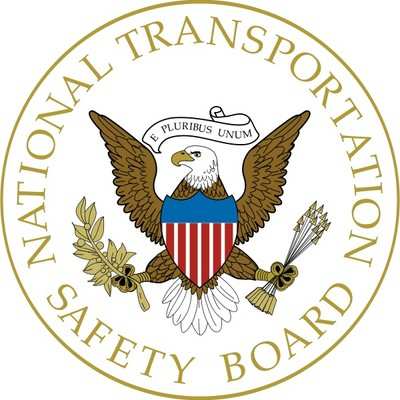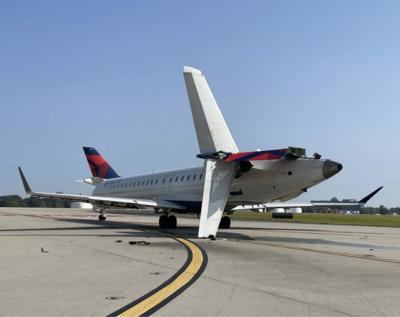Right Wingtip Of The A350 Impacted The Vertical Stabilizer Of The CRJ
Location: College Park, GA Accident Number: DCA24FA299
Date & Time: September 10, 2024, 10:07 Local Registration: N503DN (A1); N302PQ (A2)
Aircraft: Airbus A350-941 (A1); Mitsubishi Heavy Industries (MHI)/Bombardier CL600 2D24-900 (A2)
Injuries: 236 None (A1); 1 Minor, 59 None (A2)
Flight Conducted Under: Part 121: Air carrier - Scheduled (A1); Part 121: Air carrier - Scheduled (A2)

On September 10, 2024, about 1007 eastern daylight time, Delta Air Lines flight 295, an Airbus A350-941, N503DN, collided with Endeavor Air flight 5526 (dba Delta Air Lines), a Mitsubishi Heavy Industries (MHI) CRJ-900, N302PQ, while taxiing for departure at Hartsfield-Jackson Atlanta International Airport (ATL), Atlanta, Georgia. (In this report, flight 295 is referred to as the A350 airplane, and flight 5526 is referred to as the CRJ airplane.) The CRJ was holding short of runway 8R on taxiway H waiting for takeoff clearance, and the A350 was taxiing along intersecting taxiway E. As the A350 passed behind the CRJ, where the taxiways intersected, the right wingtip of the A350 impacted the vertical stabilizer of the CRJ, which resulted in substantial damage to the empennage of the CRJ and minor damage to the A350. The passengers and crew aboard both airplanes were not injured except for a flight attendant aboard the CRJ, who sustained a minor injury. The A350 was operating under the provisions of
Title 14 Code of Federal Regulations Part 121 as a scheduled international passenger flight from ATL to Tokyo Haneda International Airport (HND), Tokyo, Japan. The CRJ was operating under Part 121 as a regularly scheduled domestic passenger flight from ATL to Lafayette Regional Airport (LFT), Lafayette Parish, Louisiana.

In response to this accident, the NTSB traveled to ATL. As part of the investigative process, the NTSB invited qualified parties to participate in the investigation. These parties are the Federal Aviation Administration (FAA), Delta Air Lines, Endeavor Air, and the Air Line Pilots Association (ALPA). The NTSB assigned group chairs in the areas of operations, airworthiness, air traffic control (ATC), aircraft performance, flight data recorder (FDR), and cockpit voice recorder (CVR).
The FDR and CVR were retrieved from both airplanes between September 10 and 11, 2024, by aircraft maintenance technicians (AMT) and NTSB personnel. Both CVRs were sent to the NTSB Vehicle Recorder Laboratory on September 13, 2024. The data from both FDRs were downloaded on-site by Delta Air Lines in the presence of NTSB personnel.
HISTORY OF FLIGHT: Four flight crew members consisting of a captain and first officer (FO), a relief captain, and a relief FO were on the flight deck of the A350. The captain was the pilot flying and the FO was the pilot monitoring.
According to statements from the flight crew members, the pilot flying briefed the long runway (09L) normally used for heavy aircraft was closed for construction. Therefore, they would be taxiing to, and departing from, runway 8R. After pushback from the gate, the flight crew received taxi instructions to proceed north on taxiway D, and hold short of taxiway G. They taxied the airplane as instructed and received further instructions to taxi on taxiway G and hold short of taxiway F. They were then cleared to taxi on taxiway F and transition to taxiway E.
After the A350 turned onto taxiway E, ground control instructed the flight crew to have the airplane follow the CRJ on taxiway E and switch to tower frequency. As the A350 continued to taxi on taxiway E, the flight crew observed the navigational alert message, “NAV GNSS-2,” on the lower electronic centralized aircraft monitor (ECAM). The FO informed the tower that they would need to stop to coordinate with maintenance before departure. ATC instructed the crew to continue straight ahead on taxiway E as able and hold short of taxiway V to work on the problem. The captain indicated that, as the airplane approached the intersection with taxiway V, he was looking straight ahead and to the left to avoid the left wingtip from impinging on opposite direction traffic coming off taxiway V.
At that time, the right wingtip of the A350 impacted the vertical stabilizer of the CRJ, which was holding short of runway 8R at taxiway H. Following the collision, the captain stopped the A350 and set the parking brake. After airport rescue and firefighting (ARFF) examined the exterior of the A350, the crew was given clearance for the airplane to return to the gate.
The captain was the pilot flying, and the FO was the pilot monitoring for the CRJ. The flight crew indicated that the airplane pushed back from the gate and that ground control instructed them to taxi to runway 8R via taxiway E. The crew completed the before takeoff checks while on taxiway E, and ATC advised the crew that the A350 would wait for them and monitor the tower frequency for takeoff. The crew reported that they complied with the instructions. The captain indicated that she maneuvered the CRJ to the hold-short line on taxiway H, set the parking brake, and awaited further instruction from ATC.
The FAA provided the NTSB with certified ADS-B latitude and longitude data. Analysis of the ADS-B and preliminary FDR data showed the airplanes collided at 10:07:46. The CRJ was stationary, and the A350 was taxiing at a groundspeed of about 12 knots. The CRJ sustained lateral accelerations of 0.5 G left followed by 0.55 G right, and the CRJ’s heading was rotated about 9° clockwise.
On September 13, the operations group met at the Delta Air Lines general offices in ATL to interview the flight crews. The airworthiness group examined the accident airplane from September 11 to 13, 2024, in ATL. According to Endeavor, the distance from the hold short line to the nose landing gear of the CRJ was approximately 56 feet. The A350 was examined at the Delta Tech Ops facility, and the CRJ was examined at the Endeavor Air facility.
The investigation continues.
 A Crazy Tesla Flying Car is Coming
A Crazy Tesla Flying Car is Coming ANN's Daily Aero-Term (11.xx.25): NonApproach Control Tower
ANN's Daily Aero-Term (11.xx.25): NonApproach Control Tower Aero-News: Quote of the Day (11.01.25)
Aero-News: Quote of the Day (11.01.25) ANN's Daily Aero-Linx (11.01.25)
ANN's Daily Aero-Linx (11.01.25) Classic Aero-TV: EAA Introduces Angle of Attack Training
Classic Aero-TV: EAA Introduces Angle of Attack Training




